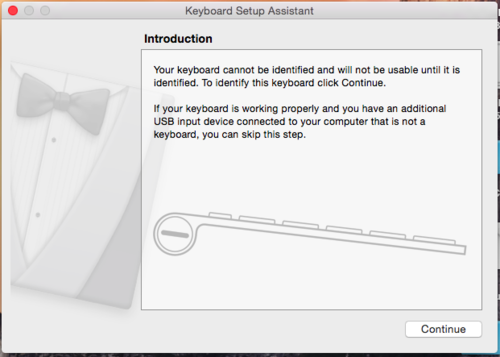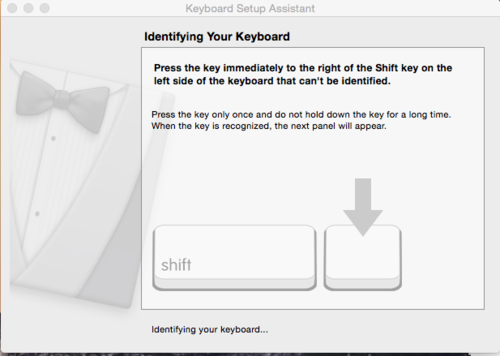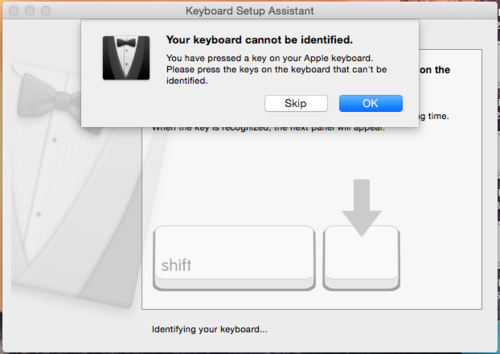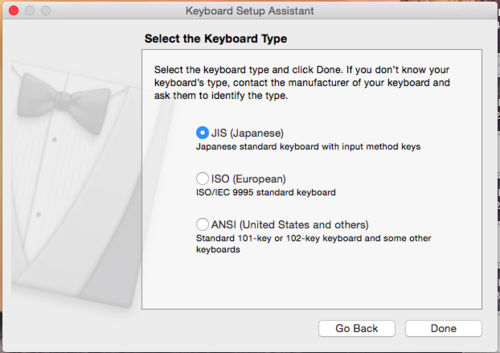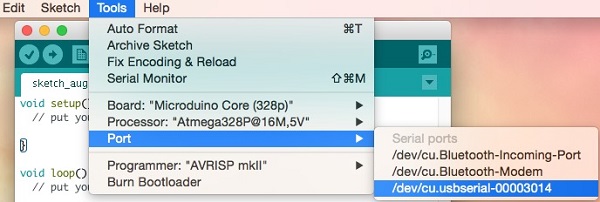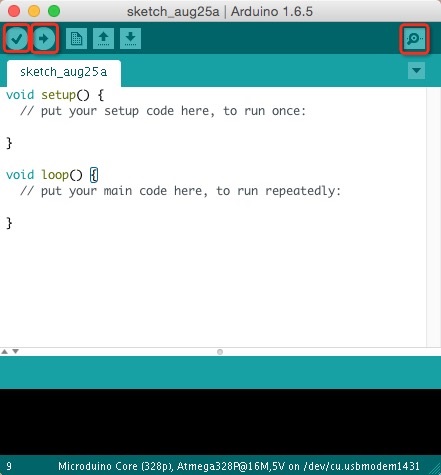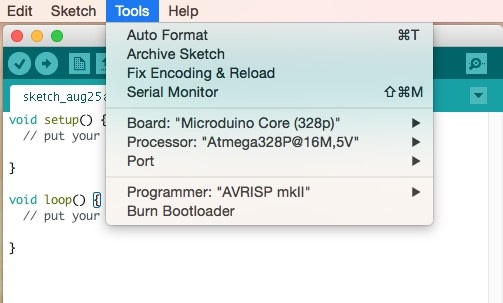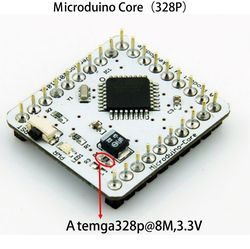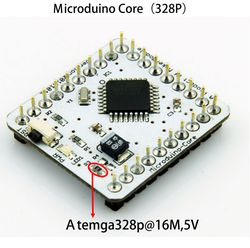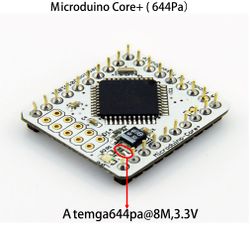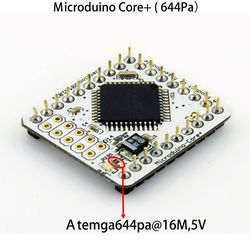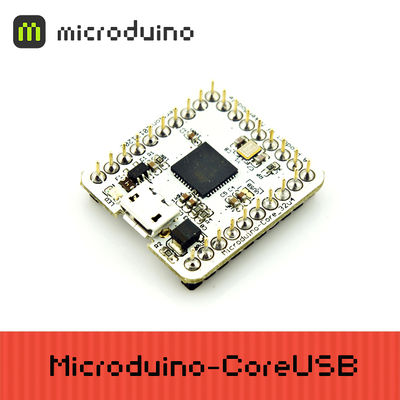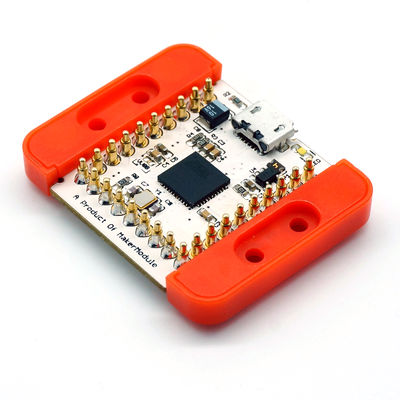“Getting started: Mac”的版本间的差异
853387039@qq.com(讨论 | 贡献) (→安装) |
(→Confirm Drivers Successfully) |
||
| (未显示3个用户的16个中间版本) | |||
| 第1行: | 第1行: | ||
| − | {{Language| | + | {{Language|Getting started: Mac}} |
{| style="width: 800px;" | {| style="width: 800px;" | ||
|- | |- | ||
| | | | ||
| − | = | + | =Download= |
| − | * | + | *Select the corresponding download for your Mac OS version: |
https://www.microduino.cc/download/ | https://www.microduino.cc/download/ | ||
| − | = | + | =Installation= |
| − | * | + | *Open the downloaded file. You will see the '''Arduino IDE''' and a '''Drivers''' folder: |
[[File:microduinoGettingStart_mac_ide.jpg|400px|center|thumb]] | [[File:microduinoGettingStart_mac_ide.jpg|400px|center|thumb]] | ||
| − | * | + | *'''If the following window appears when trying to open "Arduino IDE for Microduino", go to: |
| + | <b> System Preferences->Security and Privacy->Change "Allow apps downloaded from:" to Anywhere.''' | ||
| + | [[File:Mac_Damaged_IDE.jpg|400px|center|thumb]] | ||
| + | [[File:Mac_System_Preference.jpg|400px|center|thumb]] | ||
| + | [[File:Mac_Gatekeeper.jpg|400px|center|thumb]] | ||
| + | *Open the '''Drivers''' folder. Then install the driver package for your particular Mac OS version: | ||
[[File:microduinoGettingStart_mac_divers.jpg|400px|center|thumb]] | [[File:microduinoGettingStart_mac_divers.jpg|400px|center|thumb]] | ||
| + | *Connect [[Microduino-CoreUSB]] or [[mCookie-CoreUSB]] to your computer. A popup will appear. Click continue. | ||
| + | [[File:mCookie_GettingStart_1_EN.png|600px|center|thumb]] | ||
| + | *Your Mac is trying to recognize the new device. Briefly press the key to the right of your shift key. | ||
| + | [[File:mCookie_GettingStart_2_EN.png|600px|center|thumb]] | ||
| + | *A popup will appear saying that your keyboard cannot be recognized. Click "Skip". | ||
| + | [[File:mCookie_GettingStart_3_EN.png|600px|center|thumb]] | ||
| + | *Select the keyboard layout for your region (ANSI for most users). Click done. | ||
| + | [[File:mCookie_GettingStart_4_EN.png|600px|center|thumb]] | ||
| − | = | + | =Confirm Drivers Installed Successfully= |
| − | * | + | *Connect [[Microduino-USBTTL]] to your computer. Verify that there are available Port options under Tools. |
| − | [[File:microduinoGettingStart- | + | [[File:microduinoGettingStart-USBTTL_mac1.jpg|600px|center|thumb]] |
| − | * | + | *Connect [[Microduino-CoreUSB]] or [[mCookie-CoreUSB]] to your computer. Verify that there are available Port options under Tools. |
| − | [[File:microduinoGettingStart- | + | [[File:microduinoGettingStart-CoreUSB_mac1.jpg|600px|center|thumb]] |
| − | =IDE | + | ==Arduino IDE Basics== |
| − | == | + | ===Interface=== |
| − | [[File:microduinoGettingStart- | + | [[File:microduinoGettingStart-IDE1.jpg|500px|center|thumb]] |
| − | * | + | *【Verify】: Checks for errors in the code. |
| − | * | + | *【Upload】: Uploads the program to a MCU. |
| − | * | + | *【Serial Monitor】: Useful in debugging programs. |
| − | == | + | ===Tools=== |
| − | [[File:microduinoGettingStart- | + | [[File:microduinoGettingStart-Tools1.jpg|600px|center|thumb]] |
| − | * | + | *【Board】: Select the corresponding core module to which the program is being uploaded. |
| − | * | + | *【Processor】: Select the corresponding processor. |
| − | * | + | *【Port】: Select the common USB port. |
| − | == | + | ===The Board Types=== |
{| style="width: 800px;" | colspan="2" | | {| style="width: 800px;" | colspan="2" | | ||
| − | [[Microduino-Core | + | When using [[Microduino-Core]], select the proper processor for your board: |
|- | |- | ||
| style="width:300px" align="left"| | | style="width:300px" align="left"| | ||
| 第59行: | 第72行: | ||
{| style="width: 800px;" | colspan="2" | | {| style="width: 800px;" | colspan="2" | | ||
| − | [[Microduino-Core+ | + | When using [[Microduino-Core+]], select the proper processor for your board: |
|- | |- | ||
| style="width:300px" align="left"| | | style="width:300px" align="left"| | ||
| 第76行: | 第89行: | ||
{| style="width: 800px;" | colspan="2" | | {| style="width: 800px;" | colspan="2" | | ||
| − | [[Microduino-CoreUSB | + | When using [[Microduino-CoreUSB]] or [[mCookie-CoreUSB]], select Microduino-CoreUSB: |
|- | |- | ||
| style="width:300px" align="left"| | | style="width:300px" align="left"| | ||
| 第92行: | 第105行: | ||
<br> | <br> | ||
| − | == | + | ===Uploading Code=== |
| − | + | #Select board type and processor. | |
| − | + | #Select the port. | |
| − | + | #Click upload. | |
| + | |||
|} | |} | ||
2015年10月29日 (四) 23:14的最新版本
| Language | English |
|---|
目录Download
https://www.microduino.cc/download/ Installation
System Preferences->Security and Privacy->Change "Allow apps downloaded from:" to Anywhere. 文件:Mac Damaged IDE.jpg 400px 文件:Mac Gatekeeper.jpg 400px
Confirm Drivers Installed Successfully
Arduino IDE BasicsInterface
Tools
The Board Types
Uploading Code
|
